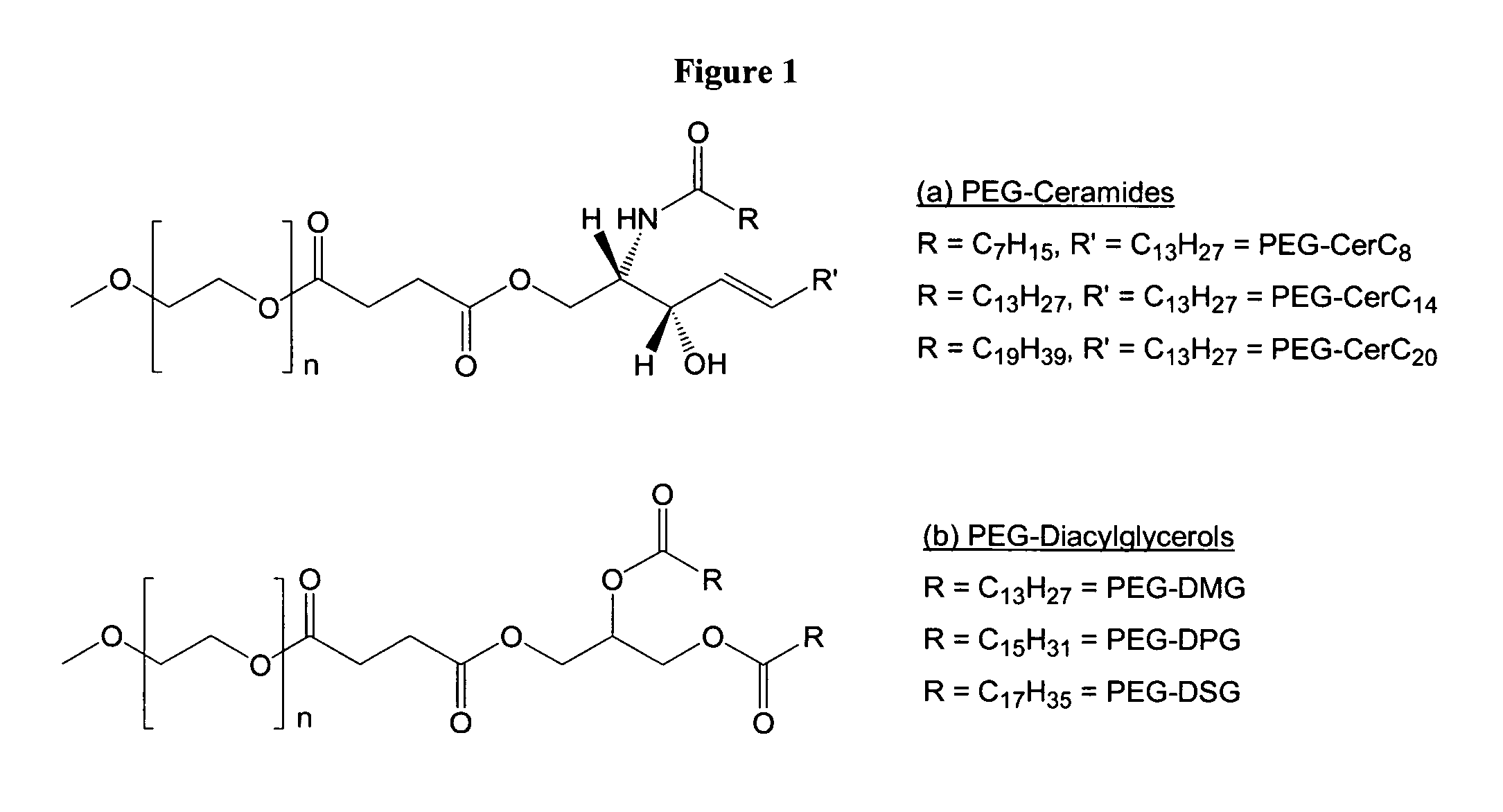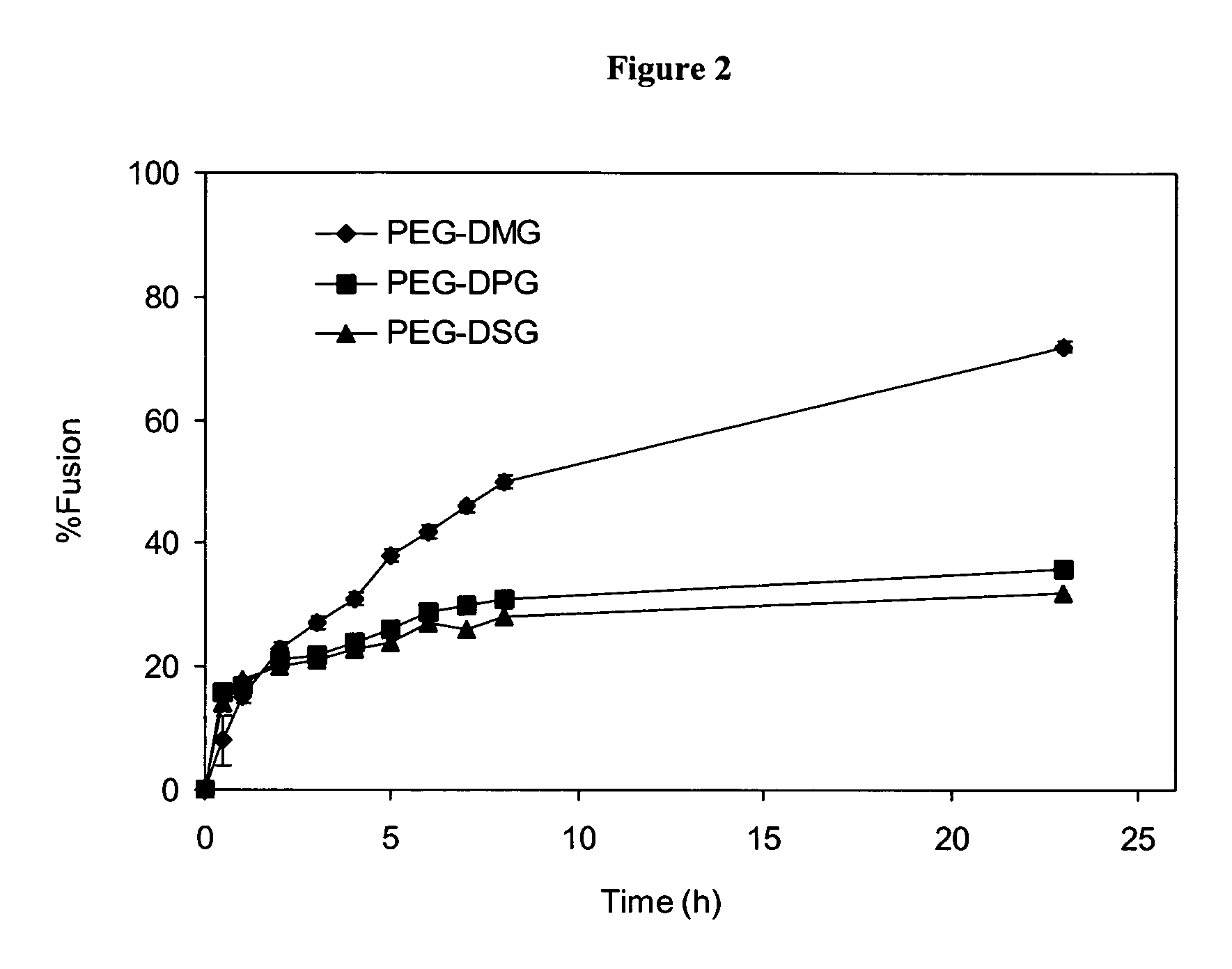Compositions for the delivery of therapeutic agents and uses thereof
a technology for pharmaceutical agents and compositions, applied in the field of compositions for the delivery of therapeutic agents, can solve the problems of less stability, less securely fastened anchors, shorter etc., and achieves greater accumulation, extended circulation lifetimes of liposomal, snalp or splp drug delivery systems, and greater stability
- Summary
- Abstract
- Description
- Claims
- Application Information
AI Technical Summary
Benefits of technology
Problems solved by technology
Method used
Image
Examples
example 1
Biodistribution, Blood Clearance and Tumor Selective Gene Expression of SPLPs Comprising PEG-lipid Conjugates
[0256] A. Materials and Methods
[0257] 1. Lipids and Plasmid
[0258] The cationic lipid DODAC and the PEG-CerC20 were synthesized as described previously (see, Monck et al., J. Drug Target., 7:439-452 (2000); and Hafez et al., Biophys. J., 79:1438-1446 (2000)). DOPE was obtained from Northern Lipids (Vancouver, BC, Canada). The detergent octyl glucopyranoside (OGP) was obtained from Sigma-Aldrich Co. (Oakville, ON, Canada). 3H-labelled CHE was obtained from Mandel NEN Products (Guelph, ON, Canada). The pCMVluc plasmid, encoding the luciferase reporter gene under the control of the cytomegalovirus promoter, was propagated in E. coli strain DH5α and purified by standard alkaline lysis / caesium chloride density gradient centrifugation. 2. Poly(ethylene glycol)-diacylglycerol Conjugate Synthesis
[0259] The poly(ethyleneglycol)-diacylglycerol conjugates (PEG-S-DAGs) were synthesize...
example 2
Expression of Nucleic Acids Encapsulated in SPLP Comprising PEG-dialkyloxypropyl Conjugates
[0293] This example describes experiments comparing expression of nucleic acids encapsulated in SPLP comprising PEG-diacylglycerol conjugates versus SPLP comprising PEG-dialkyloxypropyl conjugates. All SPLP formulations comprise a plasmid encoding luiferase under the control of the CMV promoter (pLO55).
Time##after finalGroupMiceCellRouteTreatmentRouteDosesinjectionAssay*A6Neuro-2aSCPBSIV148 hrsBody weights,B6Neuro-2aSCSPLP PEG-IV148 hrsBlood analyses,DSGLuciferaseC6Neuro-2aSCSPLP PEG-IV148 hrsactivityDSPED6Neuro-2aSCSPLP PEG-IV148 hrsCeramideC20E6Neuro-2aSCSPLP PEG-A-IV148 hrsDSAF6Neuro-2aSCSPLP PEG-C-IV148 hrsDSAG6Neuro-2aSCSPLP PEG-S-IV148 hrsDSA
[0294] All SPLP formulations contained pLO55 and DSPC:Chol:DODMA:PEG-Lipid (20:55:15:10). The following formulations were made:
[0295] A: PBS (pH 7.4).
[0296] B: L055 PEG-DSG SPLP, 0.50 mg / ml.
[0297] C: L055 PEG-DSPE SPLP, 0.50 mg / ml.
[0298] D: L0...
example 3
Expression of Nucleic Acids Encapsulated in SPLP Comprising PEG-dialkyloxypropyl Conjugates
[0305] This examples describes experiments comparing expression of nucleic acids encapsulated in SPLP comprising PEG-dialkyloxypropyl conjugates. All SPLP formulations comprise a plasmid encoding luiferase under the control of the CMV promoter (pLO55)
##GroupMiceTumorRouteTreatmentRouteDosesTimepointASSAY***A4Neuro-SCPBSIV148 hrsBody weights,2aBlood analyses,B5Neuro-SCSPLP PEG-DSGIV148 hrsLuciferase2aactivityC5Neuro-SCSPLP PEG-A-DSAIV148 hrs2aD5Neuro-SCSPLP PEG-A-DPAIV148 hrs2aE5Neuro-SCSPLP PEG-A-DMAIV148 hrs2a
[0306] The lipids (DSPC:CHOL:DODMA:PEG-Lipid ) were present in the SPLP in the following molar ratios (20:55:15:10). The following formulations were made:
[0307] A: PBS sterile filtered, 5 mL.
[0308] B: pL055-SPLP with PEG-DSG, 2 mL at 0.50 mg / mL.
[0309] C: pL055-SPLP with PEG-A-DSA, 2 mL at 0.50 mg / mL.
[0310] D: pL055-SPLP with PEG-A-DPA, 2 mL at 0.50 mg / mL.
[0311] E: pL055-SPLP with...
PUM
| Property | Measurement | Unit |
|---|---|---|
| Temperature | aaaaa | aaaaa |
| Fraction | aaaaa | aaaaa |
| Fraction | aaaaa | aaaaa |
Abstract
Description
Claims
Application Information
 Login to View More
Login to View More - R&D
- Intellectual Property
- Life Sciences
- Materials
- Tech Scout
- Unparalleled Data Quality
- Higher Quality Content
- 60% Fewer Hallucinations
Browse by: Latest US Patents, China's latest patents, Technical Efficacy Thesaurus, Application Domain, Technology Topic, Popular Technical Reports.
© 2025 PatSnap. All rights reserved.Legal|Privacy policy|Modern Slavery Act Transparency Statement|Sitemap|About US| Contact US: help@patsnap.com



